Noreen Whysel’s address to the 2017 Initiate Class of the Beta Phi Mu Theta honor society at Pratt Institute School of Information given on May 17, 2017. Slides are available at Google Slides.
Thanks to Dean Tula Giannini, Vinette Thomas, Beta Phi Mu initiates, graduates and guests. And especially to Karen Erani for inviting me to speak today. This is an honor.
Today I am going to talk about Dreams, Resilience and Making a Difference. Our goal as we embark on this journey is to make a difference. Whether we leave Pratt to become a school librarian, a legal or medical librarian, a UX designer, an archivist, we do so to serve the information needs of some group of people.
We came with our dreams of what that life will be like. We study, we make sense of all the messes. (I think I see every class I took here in this picture)… and we deliver a neatly organized and usable semblance of information our users and patrons need.
But between our dreams and our goal of making a difference is resilience. Resilience is a quality that allows us to cope with whatever the world throws at us. And because we stand between the deluge of Information and the people we serve sometimes it can feel like this [photo of lone house after a flood]. We hope to be strong like this house built to survive the floodwaters of Hurricane Ike in July 2008. We don’t expect to face this exact scenario of course….
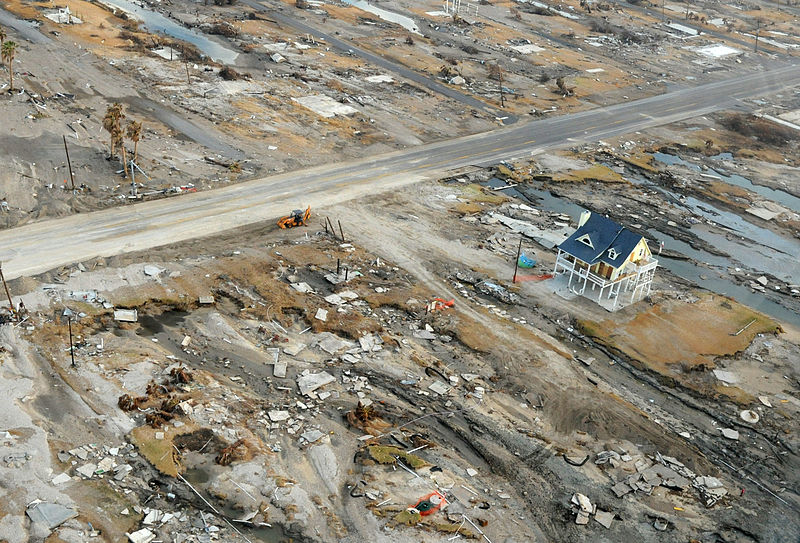
Usually, it’s a smaller disaster, a mess that you wish was neater…Even this [photo of moldy files] is probably more than most of us will ever deal with, but we studied to learn the frameworks for sorting through whatever is thrown at us, and we persevere.
So let’s unpack this. Resilience. It’s the capacity to recover quickly from difficulties; toughness. In materials science, it’s elasticity or the ability of a substance or object to spring back into shape. We call this “bouncing back” for a reason.
So, when I told Karen that I wanted to talk about resilience, I didn’t know that was also going to be the subject of Adam Grant’s address to the graduating class at Utah State University last weekend. I guess it’s a common theme.
You may know that Adam Grant is a professor of organizational psychology at the Wharton School at the University of Pennsylvania, and that he recently published a book, Option B, with Facebook’s Sheryl Sandberg on the topic of resilience. Grant’s speech reviewed typical topics for commencement addresses and boiled them down to three virtues: generosity, authenticity, and grit, for which resilience is the key component.
- Being generous on the days when you lose faith in humanity
- Staying true to yourself on the days when others lose faith in you
- Persevering on the days when you lose faith in yourself
In Grant’s words, too much of any of these three qualities diminishes your ability to bounce back from adversities. We may think that grit resembles resilience the most. Toughness and an ability to persevere can get you through trouble, but go too far and you are no longer able to help others or align your actions with the dreams that make you who you are. If you are too tough you can’t bounce back. If you are too generous, you may lose yourself.
I had trouble with the idea of being too authentic, but maybe it has to do with holding to tightly onto ways that have worked in the past that may not be helpful in the current situation. We’ll get back to this. But enough of Adam. Back to my talk.
Resilience is the quality that lets you follow your dreams so you can make a difference. It’s more than grit (and this is where my presentation departs a bit from Adam Grant’s). To practice resilience, you need to have an action plan for when things don’t go your way and another plan for mitigating the bad things that do inevitably happen [See NYC’s Ready New York Guides]. This is essential practice in emergency management, which is an area I have studied for many years, predating my time at Pratt.
If you are safe, whether that means financially or physically secure, you are in a better place to help others. If you are mindful, you can understand where your needs and capabilities fit into a given situation, and where you don’t, or where you may need to ask for help. And with a solid plan, you have a framework for doing your best even if it is something you haven’t done before or aren’t sure you are up to.
Security and planning are the same in institutional resilience. There are elements to mindfulness in institutional resilience but it manifests itself as a kind of transparency and situational awareness that is common throughout the team and the partners dealing with an incident. Emergency responders call this a COP: Common Operating Plan (or Picture). It’s a playbook that everyone knows by heart and can be augmented by information technologies.
I came to Pratt for guidance on the frameworks that help to sort information, particularly about the resilience of Cities, because I, along with many other GIS people who had volunteered at the 9/11 rescue and recovery, had a dream to ensure that the work of those who mapped the disaster would be preserved and understood as a component of our city’s core resilience.
9/11 was a difficult experience to go through—I don’t know how many of you were in NY at the time—But while it was unique in its own way, disasters of its magnitude are not uncommon here in the US and worldwide. Whether man-made disasters like 9/11/2001 or natural disasters like Hurricane Katrina’s devastation on the Gulf Coast in 2005; or a combination, as in the Tohoku Tsunami that led to a nuclear meltdown in Fukushima, Japan in 2013. Preparation for an emergency event begins with gathering resources, mapping them, and ensuring that the action plan is delivered to the right people.
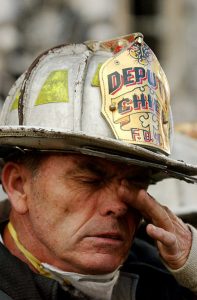
What happened next was a kind of mass, volunteer mobilization that could never have happened by the book. I was a part of a GIS user group called GISMO, who had been working slowly and not particularly successfully to get city agencies to exchange maps and underlying data. Unfortunately, we weren’t really prepared for this magnitude of devastation. But we had some hope and some really smart people, who were already figuring these things out.
The first meetings in response to the WTC attacks took place at the Department of Environmental Protection, who had responsibility for water, sewer and air quality systems throughout the city, which were particularly vulnerable. It soon became clear that a larger space would be needed to produce the maps and information required by emergency response teams. The Emergency Mapping and Data Center, or EMDC, was established on Pier 92 on the Hudson River and served as a headquarters for the rescue, recovery and mitigation efforts of city, federal and military teams.
These initial efforts and the partnerships that arose out of the EMDC formed what would become policies, toolsets and a “common operating picture” that would prepare the City for future incidents requiring collaboration among many different agencies and partners.
Innovations in response processes, tools and equipment have been documented and were presented at a ten-year retrospective held at the Technology in Government conference in 2011, called the NYC GeoSymposium 2001-2011-2021.
This is a poster I created for the symposium outlining ten years of incidents reported by the Office of Emergency Management:
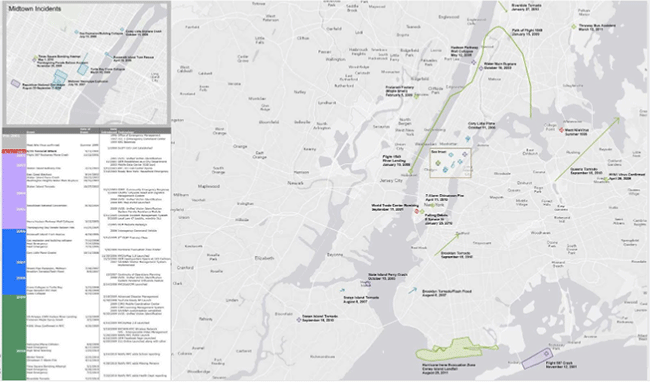
Here is a detail from my ArcGIS Explorer presentation:
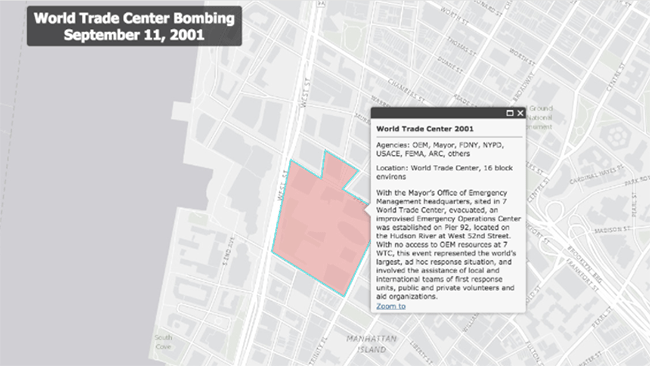
Some of the tools and artifacts that were created include updates to the very first citywide basemap, to be called NYCMAP. This map, first shot in 1999, combined aerial photography with street and building data to give a bird’s eye view of the City and its surface infrastructure. NYCMAP has developed into many versions of publicly accessible maps that are now available on the City Planning department’s website. For example, the Hurricane Evacuation Zone Finder was created in 2006 in response to Hurricane Katrina. During Hurricane Irene in 2011, WNYC.org and The NY Times created their own versions of maps that users could update with their own conditions reports.
After the WTC attack, a new Office of Emergency Management was built in Brooklyn, away from City Offices but with quick access to downtown Manhattan via the Brooklyn Bridge. It was originally created as an office of the Mayor but has since become a fully fledged Emergency Management department. Here is the floor plan of New York City’s Emergency Operations Center, located in Brooklyn near Cadman Plaza north of the courthouses.
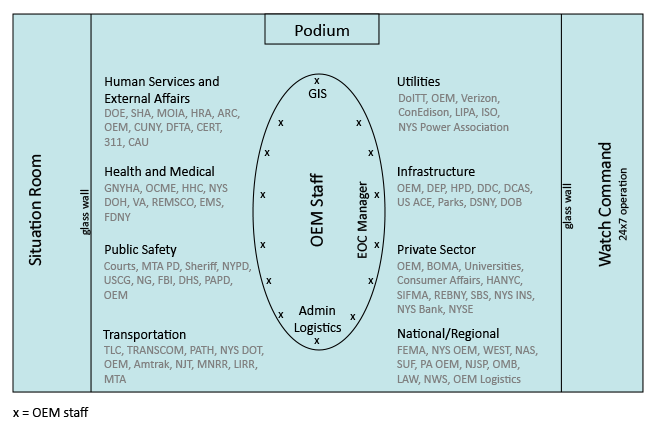
It gives a sense of how various response partners are organized on site. It’s sort of a physical information architecture. During a large-scale event, including weather events, multiple agencies are on hand to inform and take guidance from Emergency Management. Agencies are grouped by type of service with GIS at the “prow” and Admin/Logistics in back, with public (left) and infrastructure groups (right) flanking the Command Station. This space is used during active incidents. The Watch Command Center is Operational at all times.
Here are some photographs of what these facilities look like:
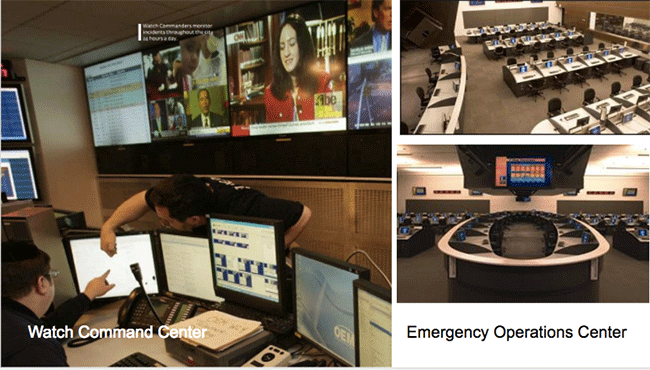
This is what a command center looks like at individual departments like FDNY:
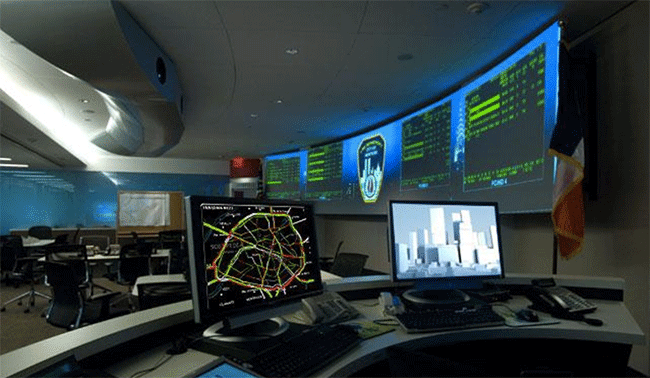
One of the results of allowing a large-scale volunteer collaboration like we had at Pier 92 (perhaps also due to the huge economic hit 9/11 had on our City) and a convergence of new technology and crowd-sourcing solutions was an increase in transparency of data and citizen participation.
This included open data initiatives from Federal to local levels, nationwide, app contests, hackathons and growing participation from citizen mappers and data scientists. This Year’s BigApps Contest will present its Finalist Expo and Awards Ceremony at Civic Hall on May 23. Go to Bigapps.nyc for tickets. They will run out quickly.
Notify NYC was another effort to inform citizens of localized incidents, via phone, web, email and SMS. Staffed by OEM Watch Commanders, Notify NYC is also available via Twitter & RSS. Multichannel public communications, including social media, allow citizens to connect with government agencies, report nuisances like rats and electric outages and access emergency preparedness resources.
So back to the dream my colleagues at GISMO and I had about creating a center of geospatial information. It’s becoming a reality.
The Center for Geospatial Innovation has been created with funding from the Fund for the City of New York. Alan Leidner, former GIS Director and Assistant Commissioner of the NYC Department of Information Technology and Telecommunications is the director. A 9/11 Geospatial Archive is a key project along with the Coalition of Geospatial Information Technology Organizations, or COGITO, which I am coordinating with additional funding from FCNY. We have collected over 650 digital and physical items including videos, maps and electronic geospatial data, as well as all of the presentations from the 2011 NYC GeoSymposium and other events.
Here are examples of some of the materials we have collected.
- Maps of Restriction zones and affected facilities prepared by the FDNY and geographers at the Emergency Mapping Center at Pier 92.
- Aerial photos.
- LIDAR images showing the extent of damage. (These were created at the Emergency Mapping and Data Center on September 17).
- We also have heat maps showing the extent of the fires burning beneath the rubble.
- Maps showing the Structural Status of buildings in the vicinity of the attack. (These were created on September 21, 2001 by Urban Data Solutions, a commercial partner).
- Maps of recovered personal objects and human remains.
- We also have a large number of photographs of activity at the Emergency Mapping and Data Center at Pier 92. [Alan Leidner is in the white shirt and beard over here on the left].
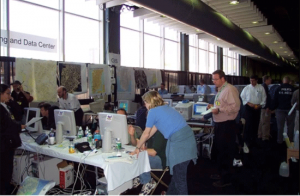
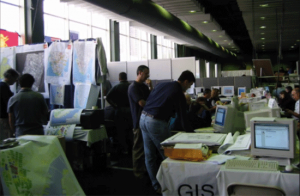
We have been able to collect names of geographers who participated in rescue and recovery from sign-in sheets, meeting notes and other documentation. LinkedIn has been a great way to find out where people who participated then are now, so we can interview them to discover additional artifacts that may be hidden in personal or official collections. We also have video interviews from the week following 9/11 identifying participants.
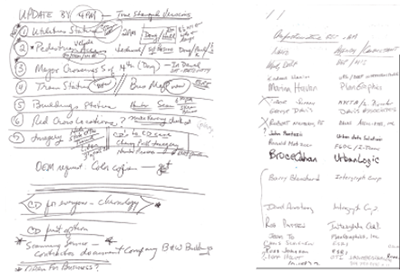
An interesting document outlined the chronology of activities from September 11 to October 12. This document contains information about participants and lessons learned in the weeks following the attack. This is resilience in action, since it was deliberately created at a time of crisis but forms policies and planning for future events. The chronology also lists participant agencies, vendors and volunteers.
In addition to the archive, the Center for Geospatial Innovation is developing outreach to GIS and Geospatial oriented groups to advise on research and development activities. COGITO: the NYC Coalition of Geospatial Information and Technology Organizations is comprised of leaders of several NYC-area and regional GIS groups. It serves as the center of an organized geospatial ecosystem in NYC and is developing activities to keep its constituent members informed of GIS opportunities, education and resources in the region.
COGITO participants include local and national GIS associations, Meetup and affinity groups, as well as university spatial data and visualization labs, including Pratt SAVI, Hunter College, CUNY Graduate School, Columbia and others. We also work with GIS offices throughout New York State to report on tools and processes that can build resilience in other local areas.
The vision for the Center for Geospatial Innovation is a City that has the ability to bounce back, Resilience, through collaboration, communication and transparency, to meet challenges like climate change, “bad actors”, or anything else that comes our way. And to recognize the historical importance and value of those who participated in creating the systems that make our City resilient. We welcome you to participate and learn about the geospatial tools that support our City’s ability to return from adversities, stronger and better prepared.
Thanks again for the opportunity to present and congratulations graduates!
If you would like to learn more about COGITO, the 9/11 Geographic Archive or if you have materials or stories that may be of interest to our future researchers and partners, please feel free to contact me.
Correction: The Center for Geospatial Innovation was referenced as the NYC Geospatial Technology Center in the original talk. Center for Geospatial Innovation is the correct name of the institution.

One Reply to “Dreams, Resilience and Making a Difference”